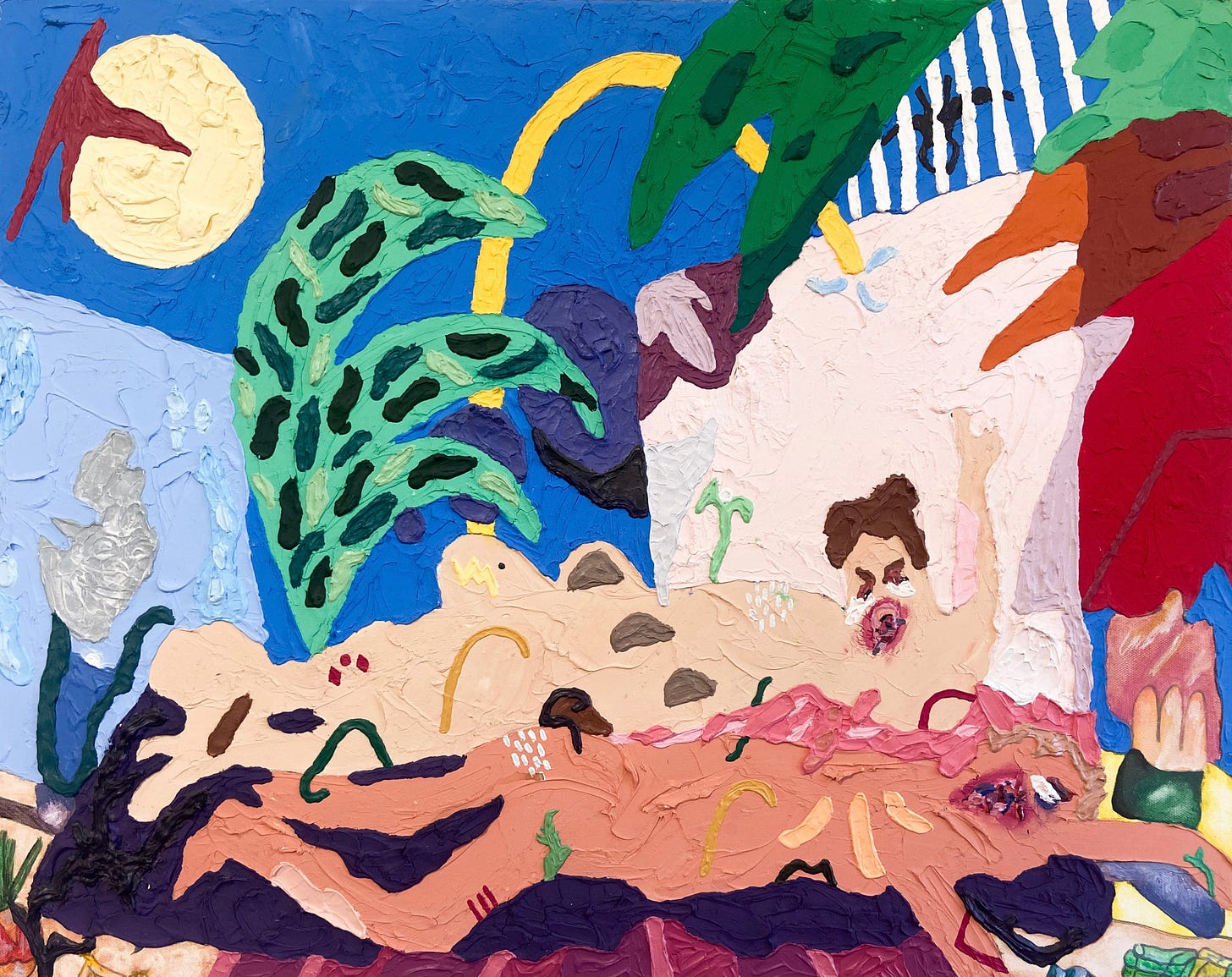Between the Thorns and the Bloom
Sebastian M. Tovar paints the raw edge of queer survival—layered, luminous, and never simple.
Sebastian M. Tovar’s paintings pulse with contradiction. In his newest solo show, Between the Thorns and the Bloom, now live on Artsy.net as part of The Pride Collection: Chosen Family, Tovar offers a richly textured world of color, body, memory, and emotion. These are not polite paintings. They do not whisper or seek neat resolutions. Instead, they thrum with tension—between intimacy and distance, euphoria and unease, celebration and survival.
From the beginning of our conversation, Tovar speaks with disarming honesty. He shares the weight of trauma, the complexity of queer intimacy, and the raw edge of living with OCD. His work, like his life, resists oversimplification. In describing Tropical Desertscape, one of the show’s centerpiece paintings, he explains:
“There are two figures on the verge of an intimate moment, but something feels off. It’s not just about beauty or eroticism. There’s an ominous energy, something hovering, that complicates the scene.”
This lurking presence is not unfamiliar. Even with his husband, intimacy can feel interrupted by trauma and dissociation.
“Dissociation becomes a kind of third presence in the room.”
Tovar doesn’t just paint figures; he paints states of being. His surfaces are thick with psychic tension—impasto textures that resemble scar tissue, flesh, and emotion layered over time.
“That presence—the shadow in the background—has always been with me. Sometimes it shows up as judgment. Sometimes as fear. Sometimes as spirits. It’s not always evil, but it’s always there. And I think a lot of queer people feel that.”
Rather than escape that shadow, Tovar brings it into his paintings—acknowledging it, transforming it, and refusing to center his practice around victimhood.
Living with OCD, particularly intrusive thoughts, deeply informs his painting process. He shares how easy it is to spiral into self-doubt and rumination during the act of painting:
“I used to paint from that dark place. But I started noticing it wasn’t processing anymore—it was just rumination. I would finish a painting and feel exhausted because I’d been mentally beating myself up the whole time.”
To counter that loop, he began reorienting his practice toward presence and joy. Painting became not just a product, but a form of healing.
“Color combinations bring me joy. Like real joy. Some colors together just make my heart soar. That’s part of the work too.”
Tovar’s studio ritual supports this shift—balancing music, silence, and physicality to stay grounded. Each brushstroke becomes a gesture of return: to the body, to the moment, to a state beyond obsessive thought.
If the shadows are always there, so is the light. Tovar critiques how tragedy often dominates queer stories in media:
“I was so mad at Brokeback Mountain. It felt like another straight-made tragedy, telling us we only have value if we die dramatically. I want more. I want joy, and complexity, and contradiction.”
This is where the show gets its name. Between the Thorns and the Bloom is not about choosing one or the other—it’s about holding them both at once.
“Queer intimacy has always had danger in it—from the AIDS crisis, from secrecy, from fear. That danger is erotic for some people. It becomes part of how we relate to one another.”
Tovar’s paintings don’t romanticize this danger. They acknowledge it. They render it through color, gesture, and form. His brushwork is thick, visceral, unafraid to be “ooey” or “gushy.”
“The thickness imitates our consciousness. It’s like fleshy layers. It lets me act out those emotions on the surface.”
Language, for him, has always been a challenge. Speaking about his work can feel limiting. But in paint, he’s fluent.
“I’ve never felt confident expressing myself in language. But painting—that’s where I don’t edit. That’s where I speak clearly.”
He lets the work speak for itself—through shimmering shapes, unresolved forms, color clashes, and emotional weight. It’s a personal grammar of survival.
Tovar also interrogates how queer bodies are viewed and consumed in today’s culture.
“We’ve become so used to seeing nudity that it doesn’t shock anymore. But where’s the emotional depth? Where’s the spirit?”
He offers a counter-vision: bodies rendered not for consumption but for contemplation. Queerness not flattened, but complex, contradictory, radiant.
What emerges on canvas isn’t a statement—it’s a process. A swirl of trauma, joy, memory, and sensuality. A refusal to collapse identity into marketable aesthetics.
His work often avoids trendiness on purpose.
“When I see something trending, I know to do the opposite. Not just to be stubborn, but because I think art gets interesting when we stop trying to replicate what works.”
In works like Maximilian, figures barely resolve. They emerge from a haze of gesture and light, more felt than defined. These are not declarative images of queerness. They’re invitations—uncertain, shifting, magnetic.
Tovar paints queerness not as spectacle, but as process. As movement. As becoming. His practice resists easy legibility in favor of deep resonance.
“I want my work to feel like something people didn’t know they needed.”
In this Pride 2025 edition, Tovar’s paintings hum with knowing. They speak not only to beauty, but to grief, contradiction, and the act of showing up despite it all.
Between the Thorns and the Bloom offers no clean resolution. It offers presence. It offers the possibility of survival through color, through complexity, through choosing joy—especially when it feels defiant.
“Survival is art. And art, at its best, makes survival radiant.”
Sebastian M. Tovar’s solo exhibition Between the Thorns and the Bloom is on view exclusively on Artsy.net from July 8 to November 5, 2025, as part of The Pride Collection: Chosen Family. Hear more in his InResidency podcast interview, streaming now on all major platforms.





